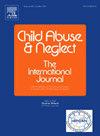The prevalence and correlates of sibling bullying victimisation in early adolescence: An investigation of over 30,000 adolescents in 18 countries
IF 3.4
2区 心理学
Q1 FAMILY STUDIES
引用次数: 0
Abstract
Background
Sibling bullying is a common childhood experience. Recent studies have shown that correlates of sibling bullying are proximal and distal. However, a lack of cross-cultural understanding still exists on the prevalence and protective factors of sibling bullying.
Objective
The objective of the current study was to examine the prevalence of sibling bullying and investigate whether positive environments protect against sibling bullying victimisation in 18 countries.
Participants and setting
We analysed existing data from an international study of over 30,000 adolescents aged 10 and 12 years old, the Children's World Survey.
Methods
Adolescents reported physical and verbal sibling bullying victimisation experiences and the positive aspects of their home, neighbourhood, and school environments. Regression models were fitted to investigate whether individual- and country-level positive home, neighbourhood, and school environments are associated with sibling bullying victimisation.
Results
On average, the prevalence of sibling bullying victimisation was 28 %; 1 in 4 adolescents were physically hurt or called unkind names more than three times in the last month by a sibling (excluding fighting or play fighting). The prevalence varied by country; ranging from 9 %–59 %. Whilst, on the whole, individual-level positive home, neighbourhood, and school environments were associated with reduced sibling bullying victimisation (odds ratios, 0.68–0.85), these effects differed for each country. Country-level positive environments were not associated with sibling bullying victimisation.
Conclusion
These findings demonstrate that improving adolescents' home, neighbourhood, and school environments might serve to reduce sibling bullying victimisation.
青少年早期兄弟姐妹欺凌受害的普遍性及其相关性:一项对18个国家30,000多名青少年的调查。
背景:兄弟姐妹欺凌是一种常见的童年经历。最近的研究表明,兄弟姐妹欺凌的相关因素是近端和远端。然而,对兄弟姐妹欺凌的流行和保护因素仍然缺乏跨文化的理解。目的:本研究的目的是调查18个国家中兄弟姐妹欺凌的流行程度,并调查积极的环境是否能防止兄弟姐妹欺凌的受害者。参与者和环境:我们分析了来自3万多名10至12岁青少年的国际研究的现有数据,即儿童世界调查。方法:青少年报告了身体和语言上的兄弟姐妹欺凌受害经历以及他们的家庭、社区和学校环境的积极方面。回归模型用于调查个人和国家层面的积极家庭、社区和学校环境是否与兄弟姐妹欺凌受害有关。结果:兄弟姐妹欺凌受害者的平均发生率为28%;四分之一的青少年在上个月被兄弟姐妹身体伤害或辱骂三次以上(不包括打架或玩耍打架)。流行程度因国家而异;范围为9% - 59%。虽然总体而言,个人层面的积极的家庭、社区和学校环境与减少兄弟姐妹欺凌受害者有关(优势比为0.68-0.85),但这些影响在每个国家都有所不同。国家层面的积极环境与兄弟姐妹欺凌受害者无关。结论:这些发现表明,改善青少年的家庭、社区和学校环境可能有助于减少兄弟姐妹欺凌的受害。
本文章由计算机程序翻译,如有差异,请以英文原文为准。
求助全文
约1分钟内获得全文
求助全文
来源期刊

Child Abuse & Neglect
Multiple-
CiteScore
7.40
自引率
10.40%
发文量
397
期刊介绍:
Official Publication of the International Society for Prevention of Child Abuse and Neglect. Child Abuse & Neglect The International Journal, provides an international, multidisciplinary forum on all aspects of child abuse and neglect, with special emphasis on prevention and treatment; the scope extends further to all those aspects of life which either favor or hinder child development. While contributions will primarily be from the fields of psychology, psychiatry, social work, medicine, nursing, law enforcement, legislature, education, and anthropology, the Journal encourages the concerned lay individual and child-oriented advocate organizations to contribute.
 求助内容:
求助内容: 应助结果提醒方式:
应助结果提醒方式:


